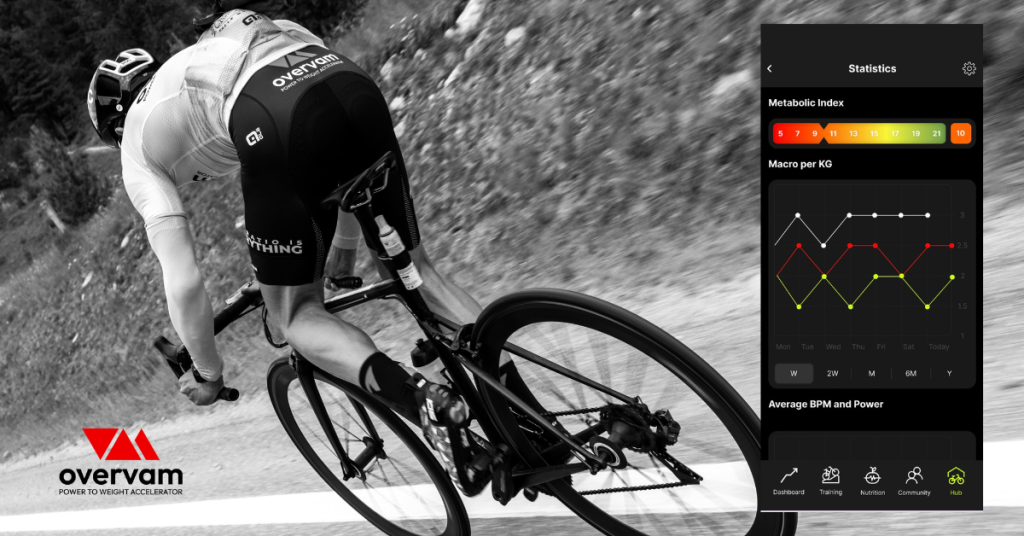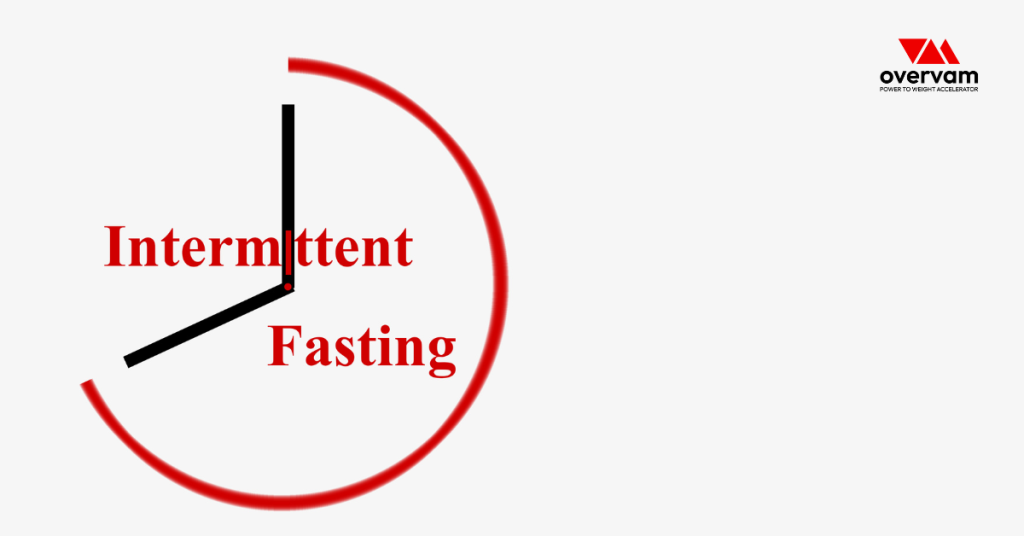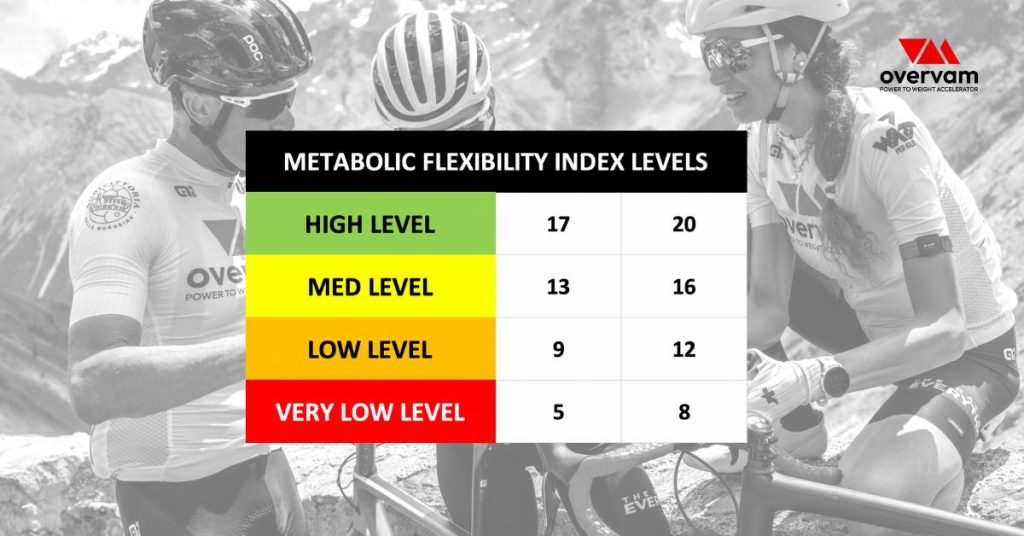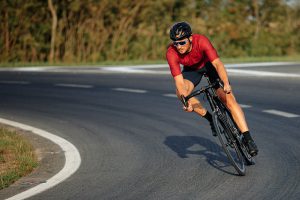INTRODUCTION
This article will explain the significance of metabolism and metabolic Flexibility for cyclists and how their measure can help improve cycling performance beyond the traditional indexes such as AT (anaerobic threshold).
Because of the various degrees of metabolic Flexibility between the sexes, different training and nutrition strategies can deliver optimal training adaptations to male and female cyclists.
Metabolic Flexibility correlates with factors such as fitness level, daily timeframe of energy intake, caloric restriction, and low-carbohydrate, high-fat diets.
Metabolic Flexibility tends to vary with ageing. As a result requiring specific attention to remain at its highest level along the lifespan, especially for lifelong cyclists.
METABOLISM AND METABOLIC FLEXIBILITY
Metabolism refers to the whole sum of reactions that occur throughout the body within each cell and that provide the body with energy (Arturo Sánchez et al., 2022).
Metabolic flexibility word was coined by Kelley et al. in 1999 when they studied fuel selection in skeletal muscle in lean and obese individuals after an overnight fast. Specifically, they discovered that the skeletal muscles of lean individuals showed a remarkable ability to adapt to fuel preference and were, therefore, designated as metabolically flexible (1).
Recent studies define metabolic Flexibility in cyclists as the capability of the organism to select fuel oxidation in response to nutrient availability and exercise intensity. The mitochondrial substrate’s overall number and efficiency influence metabolic Flexibility.
Increased values of lactate thresholds, VO2max and Fatmax (maximal rate of fat oxidation) may define a higher metabolic flexibility. (2) Pro cyclists of world-class level are among the most metabolically flexible individuals.
WHY IS IT IMPORTANT TO INCREASE METABOLIC FLEXIBILITY?
Metabolic inflexibility is the inability of the body to adjust energy substrate utilization. Low Metabolic Flexibility in cycling training and racing may relate to a shorter time to exhaustion and an early incurrence of fatigue.
On the health side, the inability to rapidly adjust energy substrate utilization correlates with obesity, sarcopenia (loss of free fat mass after age 40), insulin resistance, type 2 diabetes, and other metabolic chronic conditions (Goodpaster et al., 2017).
HOW IS POSSIBLE TO INCREASE METABOLIC FLEXIBILITY?
METABOLIC FLEXIBILITY AND EXERCISE
Physical exercise influences metabolic Flexibility to the greatest extent because it modify overall mitochondrial number, size and density. (3).
One hour/week at 45% of Vo2max for 12 weeks may be the minimum exercise load to stimulate maximal aerobic capacity (VO2max) and systemic fat oxidation, both markers of metabolic Flexibility in cyclists (Pruchnic et al., 2004).
However, several years may be optimal to achieve a high level of metabolic flexibility (Menshikova et al., 2006) and up to 10+ years may be needed to reach the elite levels of a pro cyclist.
METABOLIC FLEXIBILITY AND EXERCISE INTENSITY
Metabolic Flexibility depends upon the skeletal muscle’s use of energy substrates at different training intensities. Skeletal muscle consists of oxidative (type I) and glycolytic (type II) fibres, which differ in their metabolic abilities.
Oxidative (type I) muscle fibres have a high mitochondrial density; as a consequence, they prefer oxidative phosphorylation for ATP production, relying primarily on fatty acid oxidation, particularly during low-intensity endurance exercise. At low intensities (< 2mM/L), lactate levels (being inversely correlated with fat oxidation) tend to remain at low levels.
Metabolic Flexibility in cyclists, according to Prof. In ̃igo San-Millan tends to increase the most, thanks to mitochondrial biogenesis, exercising at low intensity, below the first lactate threshold (2 mM/L)

On the contrary, glycolytic muscle fibres (type II) have a low mitochondrial density and rely predominantly on the breakdown of stored glycogen by glycolysis for their ATP production. Glycolytic fibres activate when exercise intensity is high, typically during HIT workouts.
Although HIT workouts may promote metabolic Flexibility, a long sequence of high-intensity interval training may blunt all of the exercise-induced molecular events associated with mitochondrial biogenesis and exercise-induced changes in the nuclear protein content of PGC-1α and p53 in human skeletal muscle, transcriptional factors responsible for mitochondrial biogenesis and metabolic Flexibility. (4)(5)(6)(7)(8)
Consequently, to achieve metabolic Flexibility in cycling, a certain degree of low-intensity exercise (< 2mM/L) should be included in all training protocols, depending on the cyclist’s fitness level, goals and cycling discipline.
METABOLIC FLEXIBILITY AND DIET
Metabolic Flexibility in cycling relies on nutritional choices as well. Recent studies showed that, upon consuming a high-fat diet, lean subjects with adequate metabolic Flexibility could increase fatty acid oxidation at the expense of glucose. In contrast, obese individuals were not. Lean individuals also showed an increased expression of genes involved in fatty acid transport and oxidation compared with little or no change in their obese counterparts (9).
METABOLIC FLEXIBILITY: NUTRITIONAL OPTIMIZATION FOR ENDURANCE PERFORMANCE
It is possible to expand the term metabolic flexibility and use it to describe the ideal metabolic state for endurance athletes by testing the responses of highly trained endurance athletes exposed to periods of contrasting macronutrient availability, particularly low carbohydrates (CHO) & moderate CHO) (10).
A low CHO diet, possibly with a small caloric deficit, should be considered an appropriate nutritional tool for male and female endurance athletes to improve metabolic Flexibility and performance (13). Adopting a low CHO diet does not cause reductions in endurance performance; this nutritional manipulation is an adequate strategy during non-crucial competition periods (i.e., off-season).

Endurance-trained women appear less metabolically flexible than their male counterparts despite similar levels of relative physical fitness. The evidence that female athletes tend to oxidize less CHO and more myocellular triglycerides than males remains partially unexplained. However, hormonal status and enzyme concentrations are among the most important causes. (11). A diet specifically manipulated for female athletes should contain an appropriate CHO level lower than the current recommendations for endurance training and racing. (10)
METABOLIC FLEXIBILITY AND DIETARY CARBOHYDRATE INTAKE
Recent studies (12) suggest that when endurance athletes adapt to a low-carbohydrate, high-fat diet (LCHF), they enhance their metabolic Flexibility since they retain the capacity to use carbohydrates at high rates (approx 100% of VO2max) during maximal time trial running on 5K distance. In detail, following an LCHF diet, athletes could generate 50% or more of their energy requirements from fat oxidation at exercise intensities up to 90% VO2max. Consequently, the crossover point for substrate utilization, i.e., the exercise intensity above which CHO oxidation is the predominant source of energy provision ~85% VO2 max.
Other robust studies (13) express different results.
Adopting an LCHF may promote higher rates of whole-body fat oxidation at varying speeds or intensities.
However, the energy cost of a shift in substrate oxidation (from CHO-based to fat-based fuels) during exercise was an increased oxygen demand for a given speed across velocities that translated to a diminished exercise economy.
A performance improvement was achieved by training and competing while consuming diets providing periodic or chronic high CHO availability, but not with the LCHF diet.
This evidence suggests that a periodized training and nutrition approach may be the best way to achieve high metabolic Flexibility in cycling while unlocking the best athletic potential.
METABOLIC FLEXIBILITY: OTHER NUTRITIONAL STRATEGIES.
In this paragraph, we’ll discover how restricting the daily timeframe of dietary energy intake can favour metabolic Flexibility.
METABOLIC FLEXIBILITY AND INTERMITTENT FASTING
An overnight fast already induces changes in metabolic Flexibility in healthy humans! During fasting, the decrease in circulating dietary carbohydrates and lipids and the decline in the insulin-glucagon ratio causes a switch toward Fatty acid oxidation (14). The concomitant increase in glucagon stimulates hepatic glycogenolysis and ketogenesis.

After an overnight fast, ketone bodies are in the micromolar range (∼30 μM for women and ∼60 μM for men) (15), emphasizing that an overnight fast already induces changes in metabolic Flexibility in healthy humans by using free fatty acids as a fuel, particularly in the skeletal muscle and heart. Because adipose tissue is the predominant source of free fatty acids, the capacity of adipose tissue to store fatty acids during caloric availability and release fatty acids during caloric restriction is an essential determinant of metabolic Flexibility (16).
METABOLIC FLEXIBILITY AND TRE (TIME-RESTRICTED EATING)
Time-restricted eating refers to restricting the time of energy intake within 24 hours. This nutritional strategy bases its approach on cicardian rithms. Circadian rhythms are the physical, mental, and behavioural changes an organism experiences over a 24-hour cycle. Light and dark have the most significant influence on circadian rhythms, but food intake, stress, physical activity, social environment, and temperature also affect them.
Cumulative studies revealed the beneficial health effects of fasting. Most fasting regimens harness their innate mechanisms of enhancing metabolic fuel switching, thus improving metabolic Flexibility. The emerging time-restricted eating (TRE) regimen includes restoring daily eating and fasting rhythms to improve metabolic Flexibility while spontaneously reducing food intake despite ad-libitum eating. (TIppairote et al., 2020)(17)
Metabolic FLEXIBILITY AND AGEING
The metabolic influence on ageing and lifespan has gained increased attention over the past decade; as such, major regulators of metabolic Flexibility play dominant roles in ageing (18).
Indeed, metabolic Flexibility correlates negatively with the loss of athletic potential in cycling.
Targeting metabolic Flexibility as a cause for ageing in normal and athletic populations may provide cues to delay the onset of age-related diseases and prolong health span.
Mitochondrial dysfunction and a cellular shift toward a glycolytic phenotype correlate to senescence and the “senescence-associated secretory phenotype”.
This evidence entails the secretion of multiple factors, such as proinflammatory cytokines, proteases, and growth factors, that have potent local and systemic effects, such as inflammation and metastasis (19). Perturbation of mitochondrial function and nutrient-sensing pathways, particularly related to glucose homeostasis, is a hallmark of Aging (19).
As such, the nutrient and energy sensing pathways (insulin/IGF, mTOR, AMPK, and SIRTs) correlate positively with fitness and longevity. Consistent with this, caloric restriction (CR) increases health span and lifespan in model organisms and improves several health markers in humans.
If you want to maximize your metabolic flexibility unlocking your full cycling potential, download OVERVAM from the App Store, Google Play or suscribe from web on OVERVAM Web.
KEY TAKEAWAYS
- Metabolic Flexibility is a parameter of performance and health.
- Metabolic Flexibility is the capability of the organism to select fuel oxidation in response to nutrient availability and exercise intensity.
- Pro cyclists of world-class levels are among the most metabolically flexible individuals.
- Low Metabolic Flexibility in cycling training and racing may relate to a shorter time to exhaustion and an early incurrence of fatigue.
- Metabolic Flexibility tends to increase the most, thanks to mitochondrial biogenesis, exercising at low intensity, below the first lactate threshold (2 mM/L)
- Nutrition can influence Metabolic Flexibility.
- A low CHO diet with a modest energy-negative balance may improve endurance performance and metabolic Flexibility in endurance athletes.
- A diet manipulated explicitly for female athletes should contain an appropriate CHO level lower than the current endurance training and racing recommendations because women appear less metabolically flexible than men.
- Low carbohydrate and high-fat diets (LCHF) may lower exercise economy and negate the increase of performance induced by increased training volume and intensity.
- Intermittent fasting and time-restricted eating are nutritional strategies that may increase metabolic Flexibility.
- Metabolic Flexibility correlates negatively with ageing, and it is a cause itself for ageing. Adopting some of the strategies in this article may prolong a healthy and athletic lifespan.
REFERENCES
- Kelley DE, Goodpaster B, Wing RR, Simoneau JA. Skeletal muscle fatty acid metabolism in association with insulin resistance, obesity, and weight loss. Am J Physiol. 1999;277(6 Pt 1):E1130–E1141
- In ̃igo San-Millan, George A. Brooks. Assessment of Metabolic Flexibility using Measuring Blood Lactate, Fat, and Carbohydrate Oxidation Responses to Exercise in Professional Endurance Athletes and Less-Fit Individuals; Sports Med DOI 10.1007/s40279-017-0751-x
- Picard M, Hepple RT, Burelle Y. Mitochondrial functional specialization in glycolytic and oxidative muscle fibres: tailoring the organelle for optimal function. Am J Physiol Cell Physiol. 2012;302(4):C629–C641.
- Granara Cesare, Rodrigo S.F. Oliveira, Johnatan P. Little, David J. Bishop. Forty high-intensity interval training sessions blunt exercise-induced changes in the nuclear protein content of PGC-1α and p53 in human skeletal muscle. Am J Physiol Endocrinol Metab. 2020 Feb 1; 318(2): E224–E236
- Lira VA, Benton CR, Yan Z, Bonen A. PGC-1alpha regulation by exercise training and its influences on muscle function and insulin sensitivity. Am J Physiol Endocrinol Metab. 2010;299(2):E145–E161.
- Battaglia GM, Zheng D, Hickner RC, Houmard JA. Effect of exercise training on metabolic Flexibility in response to a high-fat diet in obese individuals. Am J Physiol Endocrinol Metab. 2012;303(12):E1440–E1445.
- Picard M, Hepple RT, Burelle Y. Mitochondrial functional specialization in glycolytic and oxidative muscle fibers: tailoring the organelle for optimal function. Am J Physiol Cell Physiol. 2012;302(4):C629–C641
- Lira VA, Benton CR, Yan Z, Bonen A. PGC-1alpha regulation by exercise training and its influences on muscle function and insulin sensitivity. Am J Physiol Endocrinol Metab. 2010;299(2):E145–E161.
- Sahar S, Sassone-Corsi P. Regulation of metabolism: the circadian clock dictates the time. Trends Endocrinol Metab. 2012;23(1):1–8
- O’Connor W.J., Metabolic Flexibility and Endurance Performance; School of Sport and Exercise, College of Health, Massey University, 2017
- Jennifer Wismann, Darryn Willoughby. Gender Differences in Carbohydrate Metabolism and Carbohydrate Loading.J Int Soc Sports Nutr. 2006; 3(1): 28–34
- Philip J. Prins , Timothy D. Noakes , Jeffrey D. Buxton , Gary L. Welton , Amy S. Raabe3, Katie E. Scott , Adam D. Atwell, Sarah J. Haley , Noah J. Esbenshade2, Jacqueline Abraham. High fat diet improves metabolic Flexibility during progressive exercise to exhaustion (VO2max testing) and during 5 km running time trials. DOI: https://doi.org/10.5114/biolsport.2023.116452
- Louise M. Burke, Megan L. Ross, Laura A. Garvican-Lewis, Marijke Welvaert, Ida A. Heikura, Sara G. Forbes, Joanne G. Mirtschin, Louise E. Cato, Nicki Strobel, Avish P. Sharma and John A. Hawley. Low carbohydrate, high fat diet impairs exercise economy and negates the performance benefit from intensified training in elite race walkers.J Physiol 595.9 (2017) pp 2785–2807
- Longo VD, Mattson MP. Fasting: molecular mechanisms and clinical applications. Cell Metab. 2014;19(2):181–192.
- aniagua JA. Nutrition, insulin resistance and dysfunctional adipose tissue determine the different components of metabolic syndrome. World J Diabetes. 2016;7(19):483–514
- Houtkooper RH, Williams RW, Auwerx J. Metabolic networks of longevity. Cell. 2010;142(1):9–14.
- Wiley CD, Velarde MC, Lecot P, Liu S, Sarnoski EA, Freund A, Shirakawa K, Lim HW, Davis SS, Ramanathan A, Gerencser AA, Verdin E, Campisi J. Mitochondrial dysfunction induces senescence with a distinct secretory phenotype. Cell Metab. 2016;23(2):303–314.
- Prashant Regmi and Leonie K. Heilbronn. Time-Restricted Eating: Benefits, Mechanisms, and Challenges in Translation. iScience 23, 101161, June 26, 2020
- Lee D, Hwang W, Artan M, Jeong D-E, Lee S-J. Effects of nutritional components on Aging. Aging Cell. 2015;14(1):8–16.

Gherardo Marcolin, BSc, IOC Diploma in Sports Nutrition, Swiss Triathlon coach, Swiss Sports Nutrition Society, MBA, Cyclist and Triathlete.




